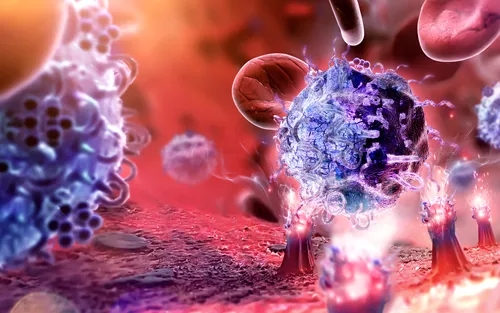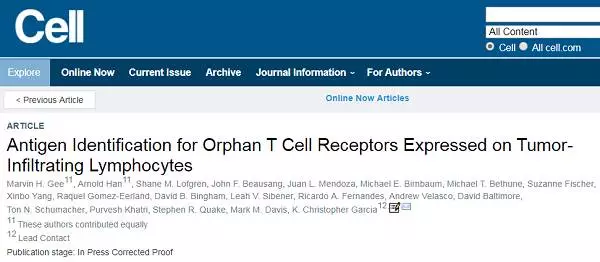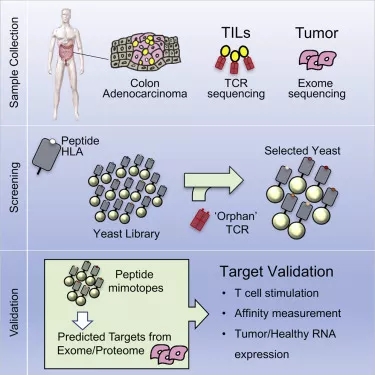The latest Cell! New technology identifies potential targets for cancer immunotherapy
December 25, 2017 Source: Biological Exploration of: Chen
Window._bd_share_config={ "common":{ "bdSnsKey":{ },"bdText":"","bdMini":"2","bdMiniList":false,"bdPic":"","bdStyle":" 0","bdSize":"16"},"share":{ }};with(document)0[(getElementsByTagName('head')[0]||body).appendChild(createElement('script')) .src='http://bdimg.share.baidu.com/static/api/js/share.js?v=89860593.js?cdnversion='+~(-new Date()/36e5)];In recent years, immunotherapy targeting popular targets such as PD-1/PD-L1 has subverted cancer treatment. However, the beneficiaries of this therapy are still limited. At present, the development of new targets has become an important research direction in this field. On December 21st, a recent paper published in Cell magazine reported a new technology for identifying potential targets for cancer immunotherapy.

Essentially, these targets are a class of molecules called antigens that appear on the surface of tumor cells and other malignant or damaged cells.
Dr. K. Christopher Garcia, a professor of molecular and cellular physiology and structural biology at Stanford University, believes that the entire basis of immunotherapy relies on the recognition of specific antigens on tumor cells by immune cells. However, at present, we know very few tumor antigens, and there is no good way to find new antigens.

In this study, using years of structural and protein engineering research, a team led by Professor Garcia tried to better understand how immune cells "see" antigens. Based on this, they developed a new technology for identifying antigens.
â–‹ How does the new technology work?
In the human body, an immune cell called a T cell is responsible for "patrolling" in the body to identify and combat foreign invaders or mutant cells. On the surface of T cells, there is a class of receptors that bind to one or more tumor cells or other harmful cell-specific antigens. When receptors find their "matching antigens", the antigen acts as a molecular command for T cells to kill unhealthy cells. However, since the matched receptor-antigen pair is difficult to obtain experimentally, many receptors are still not recognized. They are called orphan receptors.
In this study, Professor Garcia and his colleagues designed screening methods using two sources: 1) orphan T cell receptors found in colon cancer tumors; 2) large numbers of leukocyte antigen sequences.
Specifically, using yeast as a vector, the team scanned approximately 400 million leukocyte antigen sequences. These sequences are likely to match 20 orphan receptors from colon cancer tissue samples. Eventually, four receptors found their matching antigens.
Professor Garcia explained: "Under genotype restrictions, receptors only bind to antigens that carry matching genotypes. Through our technology, we have clearly identified two human antigens for the four receptors."

â–‹ 2 What is the significance of the research results?
Researchers say that at present, there is debate in the academic community about the most important types of antigens seen and attacked by T cells. A more popular view is that T cell receptors react with antigens that are mutated or uniquely part of a cancer, rather than with cancer cells and health. The cells have their own antigen (self-antigen).
Unexpectedly, however, one of the two antigens identified in this new study is an autoantigen. In addition, the study also showed that 2 patients shared this autoantigen.
Professor Garcia said: "It is a huge surprise to discover that one of the antigens is a non-mutated, shared self-antigen. This means that if we screen for more T-cell receptors, We may find many shared antigens. In theory, when we design an immunotherapy that targets such antigens, it may work for many patients."
However, Professor Garcia stressed that there is a very important question behind this, how to generate anti-tumor immunity against this antigen (antigen shared by healthy cells and cancer cells)? "Now, we have no answer yet, but many people are working hard to solve this problem. This is also a problem we must solve. We must figure out how to attack the tumor locally without harming other parts of the host," he said.
Reference materials:
1)New technique could reveal immunotherapy targets, study finds
2) Antigen Identification for Orphan T Cell Receptors Expressed on Tumor-Infiltrating Lymphocytes
Active Pharmaceutical Ingredients
Product categories of Active Pharmaceutical Ingredients, we are specialized manufacturer and distributor from China, we have the perfect after-sales service and technical support. Look forward to your cooperation!
Active Pharmaceutical,Extracted from Chicken Bile,CAS NO.:81-25-4, Active Pharmaceutical Ingredients
SINOCHEM PHARMACEUTICAL CO., LTD , https://www.sinochemnutrition.com